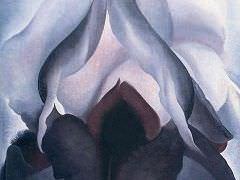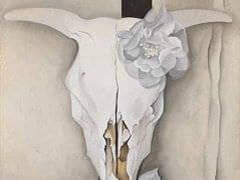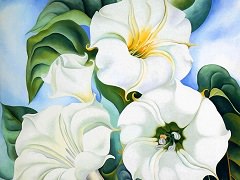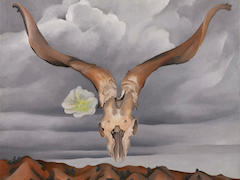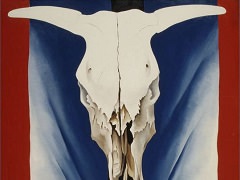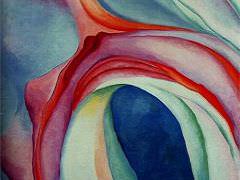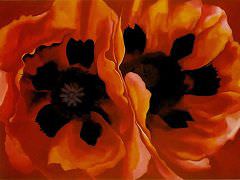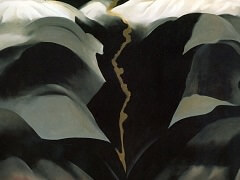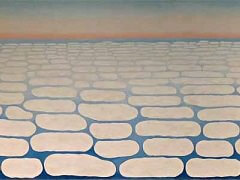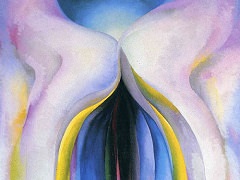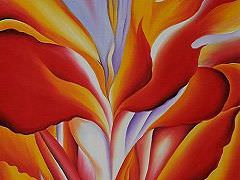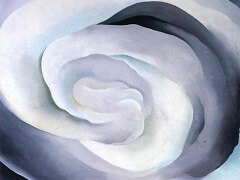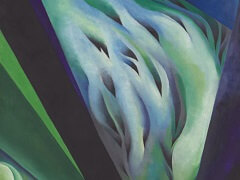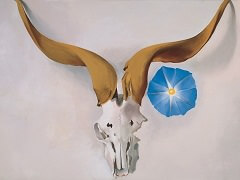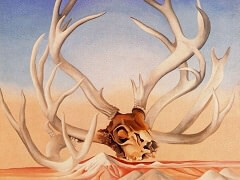Georgia O'Keeffe Facts
1. Georgia O'Keeffe consistently battled against the Freudian interpretations of her flower series.
Austrian psychoanalyst Sigmund Freud was becoming popular in the United States in 1920s. Freud, the father of psychoanalysis, had written that one way of looking at art, besides its aesthetic value, was as an expression of the artists unconscious thoughts or desire. With Judy Chicago, the feminist art movement of the 1970s attempted to commandeer O'Keeffe for her "feminine iconography," but she refused to collaborate with them on any projects. Biologically, the centers of flowers are androgynous, not feminine, alright? These flowers were not painted in praise of labia, conversely, these ravenous views are tributes to the sensual forces and ecstasy of nature itself.
2. Flower paintings make up a small percentage of O'Keeffe's paintings.
Though O'Keeffe is most famous for her lovingly rendered close-ups of flowers - like Black Iris and Oriental Poppies - these make up just about 200 of her 2000-plus paintings. The rest primarily depict landscapes, leaves, rocks, shells, and bones.
3. She quit painting three times in her life.
The first break spanned several years (the exact number is a matter of debate), when O'Keeffe took on more stable jobs to help her family through financial troubles. In the early 1930s, a
nervous breakdown led to her hospitalization, and caused her to set aside her brushes for more than a year.
In the years leading up to her death in 1986, failing eyesight forced O'Keeffe to give up painting entirely. Until then, she fought hard to keep working, enlisting assistants to prepare her
canvas and mix her oil paints for pieces like 1977's Sky Above Clouds/Yellow Horizon and Clouds. She managed to use watercolors until she was 95.
4. She was given a one-woman exhibition in 1946 at the Museum of Modern Art in New York - the first given by that museum to a woman.
5. She is the mother of American Modernism
Her major retrospective in 1970 at the Whitney Museum of American Art, placed her as one of the most important and influential American painters.
6. She married the man behind her first gallery show.
"At last, a woman on paper!" That's what modernist photographer and gallery owner Alfred Stieglitz cried when he first saw O'Keeffe's abstract charcoal drawings. He was so enthusiastic
about this series of sketches that he put them on display - before consulting their creator.
When O'Keeffe arrived at his gallery, she wasn't pleased, and brusquely introduced herself: "I am Georgia O'Keeffe and you will have to take these pictures down." Despite their rocky
beginnings, Stieglitz and O'Keeffe quickly made amends, and went on to become partners in art and in life.
7. O'Keeffe and Stieglitz wrote 25,000 pages of love letters to each other.
When the pair met in 1916, he was famous and married; she was unknown and 23 years his junior. All the same, they began writing to each other often (sometimes two or three times a day) and at length (as many as 40 pages at a time). These preserved writings chart the progression of their romance - from flirtation to affair to their marriage in 1924 - and even document their marital struggles.

